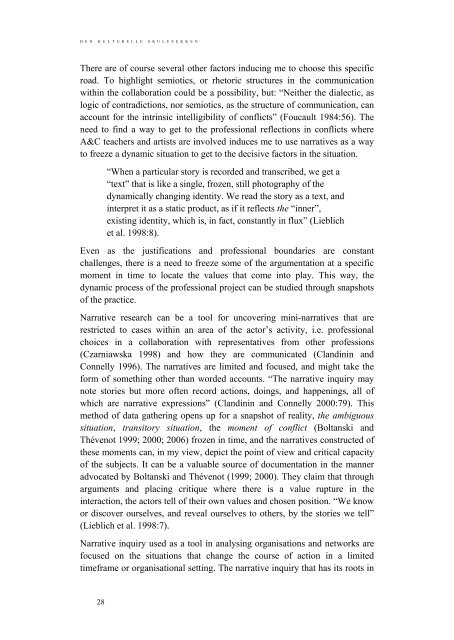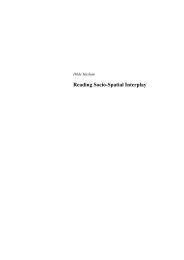CON ⢠TEXT - Arkitektur- og designhøgskolen i Oslo - AHO
CON ⢠TEXT - Arkitektur- og designhøgskolen i Oslo - AHO
CON ⢠TEXT - Arkitektur- og designhøgskolen i Oslo - AHO
- No tags were found...
You also want an ePaper? Increase the reach of your titles
YUMPU automatically turns print PDFs into web optimized ePapers that Google loves.
D E N K U L T U R E L L E S K U L E S E K K E NThere are of course several other factors inducing me to choose this specificroad. To highlight semiotics, or rhetoric structures in the communicationwithin the collaboration could be a possibility, but: “Neither the dialectic, asl<strong>og</strong>ic of contradictions, nor semiotics, as the structure of communication, canaccount for the intrinsic intelligibility of conflicts” (Foucault 1984:56). Theneed to find a way to get to the professional reflections in conflicts whereA&C teachers and artists are involved induces me to use narratives as a wayto freeze a dynamic situation to get to the decisive factors in the situation.“When a particular story is recorded and transcribed, we get a“text” that is like a single, frozen, still phot<strong>og</strong>raphy of thedynamically changing identity. We read the story as a text, andinterpret it as a static product, as if it reflects the “inner”,existing identity, which is, in fact, constantly in flux” (Lieblichet al. 1998:8).Even as the justifications and professional boundaries are constantchallenges, there is a need to freeze some of the argumentation at a specificmoment in time to locate the values that come into play. This way, thedynamic process of the professional project can be studied through snapshotsof the practice.Narrative research can be a tool for uncovering mini-narratives that arerestricted to cases within an area of the actor’s activity, i.e. professionalchoices in a collaboration with representatives from other professions(Czarniawska 1998) and how they are communicated (Clandinin andConnelly 1996). The narratives are limited and focused, and might take theform of something other than worded accounts. “The narrative inquiry maynote stories but more often record actions, doings, and happenings, all ofwhich are narrative expressions” (Clandinin and Connelly 2000:79). Thismethod of data gathering opens up for a snapshot of reality, the ambiguoussituation, transitory situation, the moment of conflict (Boltanski andThévenot 1999; 2000; 2006) frozen in time, and the narratives constructed ofthese moments can, in my view, depict the point of view and critical capacityof the subjects. It can be a valuable source of documentation in the manneradvocated by Boltanski and Thévenot (1999; 2000). They claim that througharguments and placing critique where there is a value rupture in theinteraction, the actors tell of their own values and chosen position. “We knowor discover ourselves, and reveal ourselves to others, by the stories we tell”(Lieblich et al. 1998:7).Narrative inquiry used as a tool in analysing organisations and networks arefocused on the situations that change the course of action in a limitedtimeframe or organisational setting. The narrative inquiry that has its roots in28
















